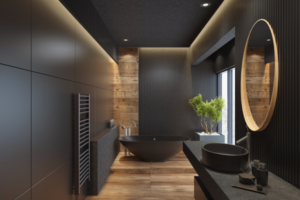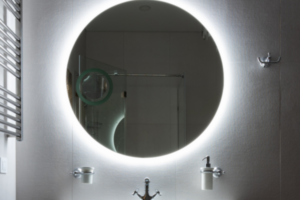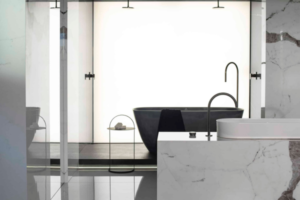Designing a small bathroom can be a balancing act between creating enough storage space and maintaining a functional, uncluttered layout. When it comes to custom cabinets, homeowners often face a common dilemma: should they opt for shelves or drawers? Both options offer distinct advantages and challenges, and the best choice depends on your specific needs, storage preferences, and the overall layout of your bathroom.
In this article, we’ll explore the pros and cons of shelves and drawers in custom cabinets for small bathrooms, helping you determine which solution will work best for your space. We’ll also look at design considerations, how to maximise space with each option, and tips for blending practicality with style.
Understanding the Role of Storage in Small Bathrooms
Storage is a critical aspect of any bathroom design, but in small bathrooms, it becomes even more important. With limited floor space and often tight layouts, it’s essential to make the most of every inch. Custom cabinets allow you to tailor storage solutions to fit your bathroom’s unique dimensions and style, ensuring you have enough space to store toiletries, cleaning products, and other essentials without creating clutter.
The choice between shelves and drawers in custom cabinets is a key decision that impacts both the functionality and aesthetic of your bathroom. Each option has its strengths, and understanding the role that storage plays in your bathroom will help guide you to the best solution.
The Advantages of Shelves in Custom Cabinets
Shelves are a classic storage solution in bathrooms, and they offer several benefits when incorporated into custom cabinets. One of the main advantages of shelves is their versatility. They can be used for storing a wide range of items, from towels to toiletries, and they make it easy to see and access what you need.
Key advantages of shelves include:
- Open and accessible: Shelves allow you to store items in an open, easily visible manner, making it easier to find what you need without rummaging through drawers or cabinets.
- Ideal for larger items: Shelves are perfect for storing bulkier items, such as towels, hair dryers, and bottles of shampoo. They provide an open space that accommodates items of various sizes and shapes.
- Customisable height: With adjustable shelves, you can tailor the height of each shelf to fit the items you need to store. This flexibility is particularly useful in small bathrooms, where storage needs may vary.
- Visual appeal: Open shelves can add a decorative element to the bathroom, allowing you to display neatly folded towels or aesthetically pleasing toiletries in a way that enhances the room’s design.
Shelves in custom cabinets can be a great solution if you need flexible, open storage for larger items. However, they do come with some potential downsides, particularly in small bathrooms where space and tidiness are crucial.
The Drawbacks of Shelves in Small Bathrooms
While shelves offer several benefits, they also have some limitations when used in small bathrooms. One of the main challenges is that they can become cluttered or disorganised if not carefully managed. Without proper organisation, shelves can quickly turn into a chaotic space filled with miscellaneous items, detracting from the minimalist aesthetic that small bathrooms often aim to achieve.
Potential drawbacks of shelves include:
- Limited organisation: Shelves don’t always offer the best solution for smaller items, which can easily get lost or become disorganised without dividers or baskets.
- Prone to clutter: Without closed doors, shelves can look messy if not meticulously maintained. Open shelving requires careful organisation to keep items looking tidy.
- Dust accumulation: Shelves, especially open ones, are more exposed to dust and moisture, which can require more frequent cleaning compared to enclosed storage options like drawers.
- Less secure: Items stored on open shelves are more likely to fall off or become disarranged, especially in a small bathroom where space is tight.
While shelves can be a good option for certain types of storage, their potential for clutter and disorganisation might make them less suitable for those who prefer a streamlined, minimal look in their small bathroom.
The Benefits of Drawers in Custom Cabinets
Drawers offer a different approach to storage in small bathrooms, and they can provide a more organised, efficient way to keep toiletries, grooming tools, and other essentials neatly tucked away. The biggest advantage of drawers is their ability to compartmentalise items, making it easy to store and organise smaller objects.
Key benefits of drawers include:
- Better organisation: Drawers allow you to neatly arrange smaller items like makeup, razors, and grooming products. Many custom drawer designs include dividers or organisers, ensuring that everything has its place and stays tidy.
- Concealed storage: Unlike shelves, drawers hide the items inside, which helps maintain a cleaner, more organised appearance. This is especially useful in small bathrooms where clutter can make the space feel even smaller.
- Maximised space: Drawers, particularly deep ones, make the most of the available space. They can hold a surprising amount of items, from toiletries to cleaning products, while keeping them out of sight.
- Easier access: Pull-out drawers provide easy access to items stored in the back, which can be difficult to reach on traditional shelves. This feature is particularly valuable in small bathrooms where deep cabinets might otherwise make items hard to retrieve.
Drawers can be an excellent choice for those who value organisation and a clutter-free environment. However, there are some downsides to consider, particularly in terms of design and accessibility.
The Drawbacks of Drawers in Small Bathrooms
While drawers can be a highly effective storage solution, they are not without their limitations. For one, drawers can be less accommodating for larger or bulkier items, which might not fit as easily into a drawer as they would on a shelf.
Some potential drawbacks of drawers include:
- Limited size for larger items: Deep drawers can store larger items like towels, but they may not be as flexible as shelves when it comes to holding bulky products like hairdryers or multiple bottles of shampoo.
- More expensive: Custom drawers, especially those with soft-close mechanisms or built-in organisers, can be more costly than traditional shelving options. This can add to the overall expense of your bathroom renovation.
- Require clearance for opening: In very small bathrooms, drawers need enough space to open fully. If your bathroom has tight corners or limited floor space, you may find that shelves or cabinets with doors are a better fit.
- Less visual display: While drawers are great for hiding clutter, they also hide any decorative items or neatly arranged products that you may want to display. If you like to use your storage to enhance the room’s aesthetic, drawers may limit those opportunities.
Despite these potential downsides, drawers are often the preferred choice for those who prioritise organisation and want to keep their small bathroom as clutter-free as possible.
Combining Shelves and Drawers for the Best of Both Worlds
For many homeowners, the ideal solution is not to choose between shelves and drawers but to incorporate both into their custom cabinets. This approach allows you to enjoy the benefits of both storage options while mitigating their respective downsides.
By combining shelves and drawers in custom cabinets, you can:
- Optimise storage for different items: Use drawers for smaller, everyday items like toiletries and grooming products, while reserving shelves for larger items like towels or decorative accents.
- Maximise accessibility: Drawers provide easy access to frequently used items, while shelves can offer quick access to bulkier items that don’t fit neatly into a drawer.
- Maintain a clean aesthetic: Combining closed drawers with open shelves allows you to strike a balance between hidden storage and decorative display, giving your small bathroom a clean, organised look.
This hybrid approach is often the most practical solution, particularly in small bathrooms where space is limited and flexibility is key.
Designing Custom Cabinets to Maximise Space
Whether you choose shelves, drawers, or a combination of both, the design of your custom cabinets plays a crucial role in maximising space in your small bathroom. Consider the following design tips when planning your custom cabinets:
- Use vertical space: Install tall cabinets with a mix of drawers and shelves to make the most of vertical space. This is especially useful in small bathrooms where floor space is limited.
- Opt for pull-out shelves: If you prefer shelves but want easier access, consider incorporating pull-out shelves into your custom cabinets. These work like drawers, allowing you to pull the shelf out to reach items stored in the back.
- Include adjustable shelves: Adjustable shelves give you the flexibility to change the height of the storage space as needed, making it easier to accommodate larger items or create more space for smaller items.
- Incorporate built-in organisers: Custom organisers inside drawers and on shelves help keep everything neatly in place. These can include dividers, baskets, or trays that ensure small items don’t get lost or clutter the space.
By designing your custom cabinets with these features in mind, you can ensure that your small bathroom remains functional, organised, and stylish.
Conclusion
When it comes to choosing between shelves and drawers for custom cabinets in small bathrooms, the best solution often depends on your individual storage needs and design preferences. Shelves offer flexibility and visibility for larger items, while drawers provide better organisation and concealment for smaller objects. Many homeowners find that a combination of both shelves and drawers offers the ideal balance between functionality and style, allowing them to maximise storage without sacrificing the aesthetic of their bathroom.
Ultimately, the choice between shelves and drawers is personal, and by customising your cabinets to suit your space, you can create a bathroom that meets your needs while maintaining a clean, organised, and spacious feel.
FAQs
Which is better for small bathrooms, shelves or drawers?
Both shelves and drawers have their advantages in small bathrooms. Shelves are great for larger items and visual display, while drawers provide better organisation and concealment for smaller items. A combination of both is often the best solution.
What are the main advantages of using shelves in custom cabinets?
Shelves offer open, accessible storage for larger items like towels or bottles, and they can add a decorative element to the bathroom. They are also flexible, especially with adjustable shelf heights.
Why are drawers a good choice for small bathrooms?
Drawers are ideal for keeping small items organised and out of sight. They allow for better compartmentalisation and are often easier to access, especially for items stored at the back of the cabinet.
Can I use both shelves and drawers in the same custom cabinet?
Yes, many custom cabinets combine both shelves and drawers. This allows you to enjoy the benefits of each, with shelves for larger items and drawers for smaller, everyday essentials.
Are drawers more expensive than shelves?
Custom drawers, especially those with soft-close mechanisms or built-in organisers, can be more expensive than simple shelves. However, they provide excellent organisation and ease of access, which may justify the cost in small bathrooms.
How can I prevent shelves from becoming cluttered?
Using baskets, dividers, or trays can help keep shelves organised. For open shelving, it’s important to carefully curate the items you store to avoid clutter and maintain a neat, tidy appearance.




